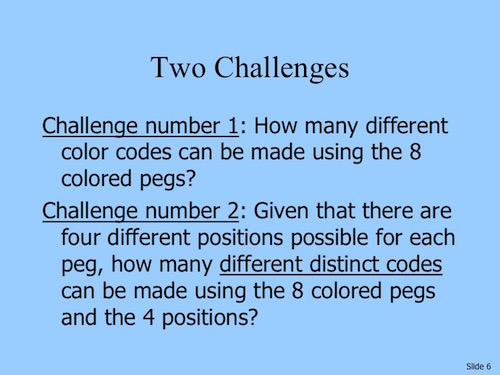Teaching is also learning. Even if teaching the same subject to the same age group year in, year out, opportunities for teachers to learn is ALWAYS there.
You can always find novel ways of teaching/imparting a knowledge and/or an understanding and/or a skill, for instance.
And in teaching something differently, you learn a great deal both in the process of designing and delivering the lessons.
In this and a number of later blog posts, I shall be sharing some of the things I did differently with my first year IB Diploma Chemistry students in Baku, Azerbaijan, in 2009-10.
Firstly, I started the year quite dramatically differently from before. Secondly, I made my students do a little differently activities I had had the class do in the past.
I started them off by making them play the game Mastermind. It’s a board game about hidden codes, consisting of colored pegs, and deciphering them logically.
(If you would like to have a go at it yourself, click here for an online version. Follow the link to the game for the rules.)
The objectives behind doing so were two-fold.
To get the students a taste for
- Modeling, deductive and inductive reasoning, and
- Going from knowledge, comprehension, application, to Higher level Thinking skills: analysis, synthesis and evaluation.
They are all skills necessary in thinking like or becoming a scientist!
(For your information, the objectives, came from my lesson plan for Monday, August 24, 2009.)
After the students had played the game long enough and had a pretty good understanding of what it was all about, I set them a couple of challenges.
The challenges didn’t end with Mastermind. Throughout the rest of the year — and this was the second thing I did differently with them — I gave them more challenges! The challenges, in addition to reinforcing curricular materials and skills, they, obviously, stretched the students as well.
To make it a little interesting and competitive, I split the class into two groups, along gender lines, and even gave it a tongue-in-cheek name of “Beautities VS. Brawns: Who’s the Brains?”
I assigned scores to each challenge and kept a running tally. Reproduced below are the challenges and the tally. (Click on the first image for a slide show.)
(If you browsed through the images, you might have noticed that I also gave them points for their performance in topic tests.)
You might also have noticed that, at the end of the year, without my having to manipulate anything ( 🙂 ), I got the results I wanted: they were tied!
In later posts, I shall give details of the individual challenges, including resources used and procedures followed etc. If teachers around the world find them useful, my time and effort publishing them will have been worthwhile!
Enjoy!
Any thoughts? Please share them below!
Update
As and when blog posts about the challenges are published, a link will be provided below.
Challenge #1. Sand Grains in the Sahara
Challenge #2. The Gunpowder Challenge: The Explosive Meet
Challenge #3. Volume of Solution
Challenge #4. Magical Crystals
Challenge #5. Green Volcano
Challenge #6. Sugar Daddy…With Flare
Challenge #7. The Burning Issue of a Candle
Challenge #8. The Pop in Popcorn
References:
Wikipedia description of the board game Mastermind.
Play Mastermind Online. Follow the above link for the rules.

